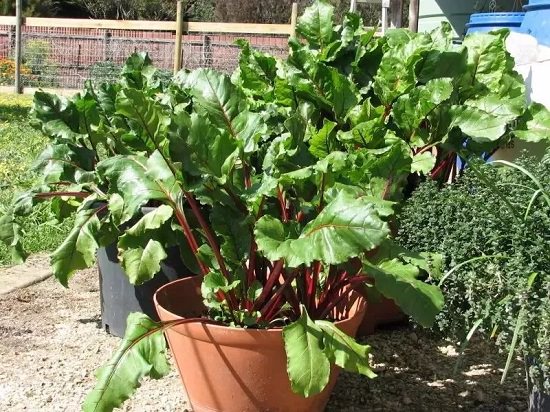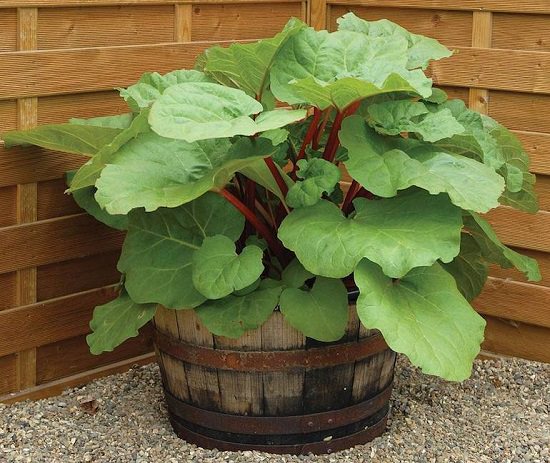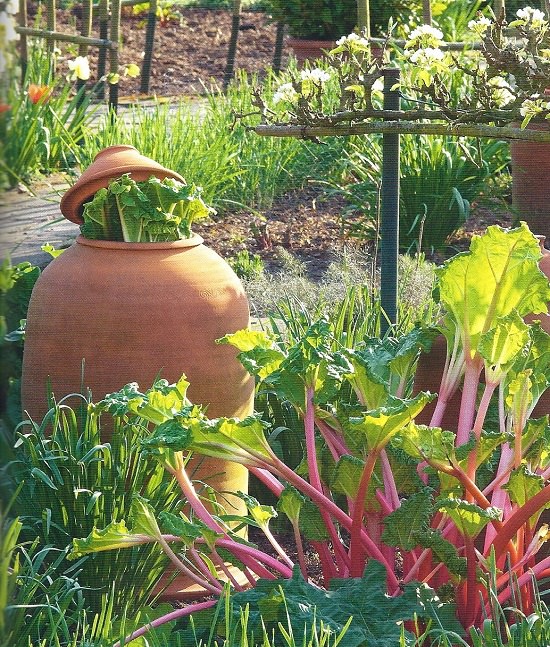Growing Rhubarb in Pots lets you have your own fresh harvest of its tender green stalks even when you don’t have a spacious garden!
Rhubarb‘s edible stalks are harvested for their rich and tart flavor. You can prepare rhubarb pies, homemade jam, or simply have sugar dipped stalks! And to ensure that you have a fresh supply for all this, there is no better way to grow them yourself! Here’s all you need to know Growing Rhubarb in Pots!
Check out our article on growing Artichokes in pots here!
Choosing a Container
An 18-22 inches deep and wide container is going to be an apt choice for rhubarb as the plant has a big root system. Must ensure that it has sufficient drainage holes at the bottom.
Planting Time
Rhubarb prefers cool weather and thrives well in the same. Plant it 4-6 weeks prior to the last average frost date in your area. You can also plant the crowns in Autumn. The plant takes 2-4 years to harvest fully. Rhubarbs can be easily grown all year round as the woody rhizomes and crown can stay frozen without any damage from cold.
For warmer climates, save the plant from excessive heat as it results in green petioles which are not as desirable as the red ones. In warmer areas like Oregon, keep the plant in shade. It does best in the average temperature of 40 F (5 C) in winters and below 75 F (22 C) in the summers.
Want to grow strawberries in a small space? Click here!
How to Grow Rhubarb in Pots?
Propagation
You can grow rhubarb from Seeds, Crowns, and Divisions.
From Seeds
Keep the seeds in warm water overnight, prior to the day of sowing. Sow them in a potting mix and water regularly, making sure that the soil is evenly moist. Avoid overwatering. The seeds are going to sprout in 2-3 weeks.
From Crowns
For a successful and shorter cultivation time, growing rhubarb from crowns is highly recommended. Dig a hole twice the size of the crown, plant it and cover with soil in a way where only the tips are exposed. Water till it drains from the holes of the pot and keep it in bright light.
From Divisions
It is best to divide the plants in Spring. Uproot the entire plant and snip off the top growth. This will expose the crown. Now, cut off the sections of the roots that appear rotten. Cut the crown into pieces in a way where you get atleast 2-3 stem buds and roots in every piece. Plant these pieces in individual pots for new plants.
Here’s everything you need to know about growing blueberries in pots!
Requirements for Growing Rhubarb in Pots
Location
It’ll do best in locations where it receives maximum sunlight. Don’t worry if you find it challenging to place it in direct sunlight; partial shade will also do. In scorching heat, move the pots to a shaded spot.
Soil
Well-draining soil rich in organic matter is best for growing rhubarb. At the time of plating, adding well-rotted manure along with a handful of bone meal fertilizer or seabird guano to the soil is going to give the plant a headstart. Adding a generous amount of garden compost in the soil will protect the crown over winter.
Always go for deep, rich, well-drained, and sandy loam soil as it provides adequate nutrients to the plant and helps it to produce an earliest crop. Make it a habit to supplement the soil in the pots with rich compost, annually.
Watering
For healthy and growing rhubarbs, it’s essential to keep the soil evenly moist. Water the plants and allow the excess water to drain out completely. Never let the soil dry and avoid overwatering the plant. For the right balance, check 1-2 inches of topsoil with your finger, if it feels dry, water the plant.
Want to grow Malabar spinach in pots? Click here!
Caring for Rhubarb in Pots
Fertilizing
For container-grown rhubarbs, you can feed them using a balanced liquid fertilizer once in 4-5 months. You can also fertilize the plant with half a cup of 10-10-10 fertilizer once in early spring and then again, in fall. Make sure to fertilize around the base, avoiding the leaves. Do not fertilize a new plant till the second year.
Pro Tip: You can also top-dress the plant, an inch or so, using chicken manure in the fall.
Mulching
Adding a top layer mulch will help the soil to retain moisture for a longer duration. Thickness can range from anywhere from 1 to 2 inches. You can use grass clippings or bark chips for mulching.
Pruning and Weeding
Take out the perennial weeds if you notice any. Cut the seed and flower stalk as soon as they appear on the plant.
Spacing
If you are growing multiple plants together, keep the pots atleast 3-4 feet apart from each other. This will give the plant’s leaves enough space to flourish and proper air circulation.
Pests and Diseases
Rhubarb is impressively pest and disease resistant! It might get affected with fungal leaf rot and to avoid the same, water at the base of the plant, avoiding leaves.
In pests, look out for rhubarb weevil, though, it is rare.
Here are some of the best summer vegetables to grow in pots!
Harvesting and Storage
- You can start harvesting the plant in the second year after planting. However, you have to wait until the third year for the full harvest. By this time, the plant will have long, red and thicker stems.
- Pull the stalks from the crown and cut away using a sharp scissor. Make sure that you are not damaging the crown in the process.
- Rhubarb is most flavorful in Spring, so harvest during that time is best.
- Do not cut away more than 1/3 of the plant in a single harvest session.
- Avoid eating rhubarb leaves as they contain oxalic acid, a toxin.
You can store the harvested stalks in a refrigerator for a week. However, it tastes best when it is fresh, especially its crispiness!






When growing rhubarb in pots, will the roots survive if cut back in the fall and allowed to freeze over a Minnesota winter?
Thanks,
Dennis